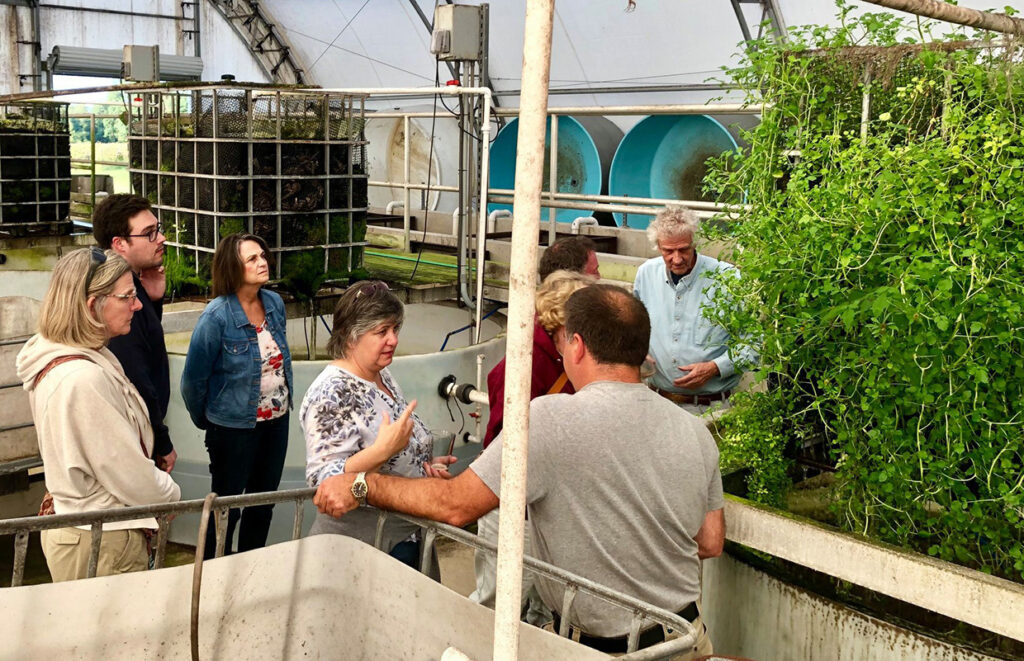
By Jon Sicotte on September 20, 2022 in Brewer Magazine
Click here for the original article (text below).

It won’t be commonplace in the craft beer and wine and spirit industries for quite some time, but New York’s Five & 20 Spirits and Brewing has teamed with a local entrepreneur in developing a system to take its spent grain, stillage, and wash water and convert it into sustainable uses outside the norm that other breweries and alcohol producers may do.
Working with TimberFish Technologies, Mario Mazza of Mazza Vineyards — the parent company of the brewery — shared how a five-year test pilot system of this emerging idea is looking to come to commercial fruition.
“It’s a really amazing technology,” explained Mario Mazza, the winery and brewstillery’s Vice President, and General Manager. “The challenge is, it’s kind of ‘big picture’ and it can be hard to wrap your head around. I never knew that 7-8 years ago when we first started talking (with TimberFish founder Jere Northrup) that I thought that I would understand recirculating aquaculture and the differences there. It is a really cool partnership.”
Five & 20 has worked at combining byproducts and waste — like stillage, spent grains, and wash water — and adding it to wood chips. The nutrients between the spent grain and the carbon source in the wood generate microbial biomass. From that, it can grow invertebrates such as larvae and worms. You can then feed a protein and grow a protein source. In this case, Timberfish and Mazza have shown they can grow freshwater shrimp, perch, and other fish over a five-year span.
“We’ve commercially demonstrated the ability to grow and raise various different types of fish,” Mazza said. “We actually did a direct feed off the microbial doing freshwater shrimp. So that whole partnership developed into a pilot facility here that we built and ran for several years … collecting all this data and demonstrating commercial feasibility.”
The facility that is on the brewstillery’s grounds has never run at full capacity but did create a couple thousand pounds of fish over the past few trials. The system that was built near Westfield, New York is scaled so that it could handle all of Five & 20’s waste. A lot of times, they would run the system for 6-8 months at a time, then shut it down over winter to make upgrades and tweaks to work on configuration and optimization.
“If we were running (all the time) we should be able to produce 10-15, maybe upwards of 20,000 pounds of fish per year,” Mazza said.
What the technology is doing is not only creating and taking waste, but it’s also using woodlot land that isn’t active in agriculture that can be sustainably managed.
“You have wood chip generation to create these wood chip zones in this system,” Mazza explained. “Now you’re using what might not have been agriculturally viable to now help generate a food source and we’re taking waste use. It can work from a brewery/distillery, it could work from a winery, it could work from a yogurt manufacturer … all these different inputs. But we’ve demonstrated that technology.”
Mazza admits that the tech is “really kind of far out there” but it can be important for sustainably managing forestry as a carbon sink becomes a viable and necessary component to the whole ecosystem.
“It’s not just about taking byproducts and not letting it become waste, but letting it become a viable food source and help with food insecurities,” he said. “Also it can help in terms of sequestration and addressing climate change issues.
“The neat part of this is it’s economically driven. These things, when built, can make money. So you can make money and take care of a byproduct stream that — in some instances — you’re paying to treat or haul away, and you can turn that into a revenue stream. It’s not a small investment, so we’re looking for them to come to fruition. We’re also looking forward to that partnership, getting the system and some capital upgrades that we want to make to it, and taking that next step.”